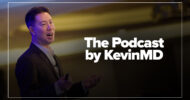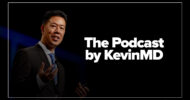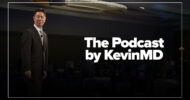Subscribe to The Podcast by KevinMD. Watch on YouTube. Catch up on old episodes!
Patient advocate Tami Burdick discusses her article, “How collaboration saved my life from a rare disease doctors couldn’t diagnose.” Tami shares her personal and arduous journey with granulomatous mastitis (GM), a rare and poorly understood condition, and how embracing collaborative health care in three key ways led to her successful remission. She details the crucial partnership between her conventional Western medicine doctor, surgical breast oncologist Dr. Kelly McLean, and her functional medicine practitioner, Jared Seigler, which allowed for innovative testing and a broader perspective on her illness. Tami also highlights the power of patient-to-doctor collaboration, emphasizing how her own relentless research and self-advocacy were instrumental in uncovering answers that the traditional system initially missed, largely due to time constraints on physicians. Furthermore, she underscores the profound impact of patient-to-patient collaboration through her support group, where shared experiences and knowledge provided critical guidance and helped others navigate the complexities of GM. Tami’s story is a testament to the potential of integrating different medical approaches, the necessity of patient empowerment, and a call for systemic changes in health care to foster more such collaborations, including better insurance coverage for alternative practices and more dedicated time for doctor-patient interactions.
Our presenting sponsor is Microsoft Dragon Copilot.
Want to streamline your clinical documentation and take advantage of customizations that put you in control? What about the ability to surface information right at the point of care or automate tasks with just a click? Now, you can.
Microsoft Dragon Copilot, your AI assistant for clinical workflow, is transforming how clinicians work. Offering an extensible AI workspace and a single, integrated platform, Dragon Copilot can help you unlock new levels of efficiency. Plus, it’s backed by a proven track record and decades of clinical expertise and it’s part of Microsoft Cloud for Healthcare–and it’s built on a foundation of trust.
Ease your administrative burdens and stay focused on what matters most with Dragon Copilot, your AI assistant for clinical workflow.
VISIT SPONSOR → https://aka.ms/kevinmd
SUBSCRIBE TO THE PODCAST → https://www.kevinmd.com/podcast
RECOMMENDED BY KEVINMD → https://www.kevinmd.com/recommended
Transcript
Kevin Pho: Hi, and welcome to the show. Subscribe at KevinMD.com/podcast. Today we welcome back Tami Burdick. She’s a patient advocate. Today’s KevinMD article is “How collaboration saved my life from a rare disease doctors couldn’t diagnose.” Tami, welcome back to the show.
Tami Burdick: Thank you so much for having me. I appreciate it.
Kevin Pho: All right, so tell us what led you to write this article on KevinMD?
Tami Burdick: I was influenced to write this article for you because of my own journey and experience when I was battling an emerging women’s health issue known as granulomatous mastitis. There’s a multitude of frustrations that patients will normally experience with a disease. We’ve talked about that in previous conversations, but it really led me to write the article because collaboration in our health care system needs to be what we should be doing moving forward. I think if we allow collaboration to really be more of an existence and a routine process or practice, we’re going to be able to provide patients better long-term solutions and care and treatment.
Kevin Pho: All right. And I think what you said about collaboration is something that is really lacking. Speaking from a physician standpoint, a lot of doctors practice in their own silos, and sometimes getting doctors to talk to one another, whether it’s primary care to specialists or vice versa, can be a difficult task. So tell us more about your article for those who didn’t get a chance to read it.
Tami Burdick: The article is based on trying to influence more collaboration in our health care system. I broke it down into three components or three types of collaboration. First, you have doctor-to-patient collaboration. For example, I had an experience with my surgical breast oncologist. She was willing to listen to me, be open to my research, and to order the tests I requested. Had she not been open, things would have been very different for me. She actually wrote in my book that she just didn’t have the time to devote to the research that I did to get the answers. While I appreciate everything that she did for me, at the same time, it should never be the patient’s responsibility to do the research and spearhead a case.
Additionally, collaboration should be seen in practices outside of Western medicine, where we blend the two approaches. In my story, my surgical breast oncologist and my functional medicine practitioner actually teamed up. So, we had the Western medicine plan of action, and then we also had, from a functional medicine perspective, considerations of when we might do certain things and if there were other things going on with me that could help explain the diagnosis.
Thirdly, another type of collaboration is patient-to-patient. With that, nobody knows your body better than you do, and no one is going to know the disease or illness better than other people going through it. So, there’s really an opportunity for different patients to team up together, and that’s what my support group that I joined is all about. We share so much information and oftentimes will find more information there than we ever would in the health care system. So, I think if we focus more on advocating for these different types of collaborations in our health care system, we can really change the overall operations and greatly improve results.
Kevin Pho: So take us into the exam room. When you had this collaboration with your surgeon and you brought the research that you did independently, what did those conversations look like?
Tami Burdick: My functional medicine practitioner had requested my surgical breast oncologist to order some tests from a Western medicine perspective, which graciously she was able to do for us. Collaboratively, we took all of the information from both practices and then we were able to create a plan of action as well as treatment, including when these therapies and when surgery (because I ended up having to have surgery) would take place.
Kevin Pho: Now, do you find this type of collaboration where a Western-trained clinician would collaborate with a functional medicine clinician? How common is that from your experience in talking to other patients in your support group and forums?
Tami Burdick: I don’t think it’s very common at all. I think partly the issue is that a lot of these health care systems really don’t give doctors the time to allocate with their patients. Oftentimes, I’ll even experience what feels like my doctor trying to rush me through the appointment. I actually experienced that recently with something. So, I’m not trying to blame the doctors here; I’m putting the weight and responsibility back onto the health care networks. We need to let doctors be doctors again.
That’s where I think there’s so much opportunity for us to have functional medicine, Western medicine, and all the other different practices team up. But they have to have the time to be able to do that, and their time is already so minimal as it is. If you do the research, I think it’s about 18 minutes on average for a doctor with a patient. Honestly, you can’t really accomplish much in that time.
Kevin Pho: So speaking from the perspective of a patient who had a difficult diagnosis that wasn’t apparently obvious, what does it mean to you that your surgical oncologist was open to your functional medicine practitioner and was able to spend that time thinking outside the box and collaborating with that research, not only with you, but with your other clinicians as well?
Tami Burdick: Dr. McClain is a very unique find, and truly I was completely blessed to be able to be her patient. She had great bedside manner. She had the ability to really listen to her patient. She was so open-minded. I think it really starts with having the right doctor and the right mindset to be able to allow these different types of collaboration to be implemented in a patient’s case.
For me, it was just so critical that this partnership took place because my journey with granulomatous mastitis had so many questions that needed answers, and they just weren’t readily there. I did a significant amount of research—months and months of it—and it took seven months before we even found what was the driving force of my disease process, which was the environmentally associated bacteria. So, it means a lot to be able to think long-term that we can bring collaboration as the new way of health care.
Kevin Pho: Now, whenever you see a new clinician, do you vet that clinician and ask them questions to see how open they are to the collaboration that you would like to see?
Tami Burdick: Yes, I get a good vibe about how the doctor is going to be, I think even from meeting them for the first time. I was so sad that my primary care physician retired earlier this year. He was very open-minded. He was like the diagnosis detective with me. He’s a doctor that really wants to dive through data, analyze it, look at symptoms, and look at everything as a whole so that the patient’s care is number one, and that’s really what it should be about. So, I definitely am vetting clinicians because if we’re not going to vibe and they’re not going to have my same mindset, then it’s just not going to be good for either one of us.
Kevin Pho: So you said that you had a vibe as to whether a clinician would be collaborative, but can you give some specifics? What specifically are you looking for, just so other patients can also get a sense of what you’re looking for whenever they’re vetting their own physicians and clinicians to see if they’re open to collaboration? What exactly do you mean by a vibe? What exactly do you look for?
Tami Burdick: So, how much is the doctor willing to sit and listen? Are they willing to be able to provide the answers to all of my questions? And I mean all of my questions. I don’t want one or two questions answered and then I have five more that are just going to be left out there and unanswered. A good vibe includes their bedside manner, getting to know me as a person and not just as somebody coming in with a symptom.
What is their approach like? Are they going to be open-minded to running tests? Because it’s happened over and over and over again, and we’ve had a podcast interview on medical gaslighting. Over 70 percent of women have reported experiencing that. So for me, I don’t want to be a victim of medical gaslighting. And for that not to happen, part of the vibe that I need from my doctor is their ability to be open to running the tests that are necessary so that we can get proper diagnosis and proper treatment.
I don’t want to be a case out there where someone has gone to their doctor saying, “Oh, I’ve got these GI issues,” and the doctor is just assuming without doing any tests or doing minimal tests, that they just have IBS or IBD, and guess what? They had colon cancer. So, I don’t want to be that case.
Kevin Pho: Do you have any advice for clinicians, as you said earlier, who are under a tremendous amount of time pressure to balance the time that they should spend collaborating with the patient and other clinicians versus the pressures that they face from the health care system? You did talk about earlier that the health care system itself needs to change, and I certainly agree with that. But how about for those individual clinicians in terms of balancing the time they should spend with difficult diagnoses versus all the other patients that they have to see waiting in the exam room? How can they balance that?
Tami Burdick: What you just said about all the other patients in the exam rooms, that goes back to the health care networks. They probably have some sort of expectations of how many patients should be seen every hour, every day, every week, and I think that needs to be reevaluated. A lot of that pressure from their networks, I think, often reflects back onto the doctors and then it reflects onto the patients. That’s something that I hope that we see change.
But if you’re not a clinician or practitioner in your own private practice, then you have this corporation-like way of doing things within the health care system. There are limitations, there are expectations, and at the end of the day, the health care system is a business. Every business out there is in it to make money, but it shouldn’t come at the cost of patient care and what they need.
Kevin Pho: What kind of advice do you have for other patients who may be going to a corporatized health care system where their physician only has 10 to 15 minutes with them? How can they better advocate for themselves to get the collaboration that you received from your medical team?
Tami Burdick: Take someone with you. I think that’s always going to be a good thing, whether it’s someone advocating for you or they’re just somebody there to help you take notes. Because then that will give you the opportunity to focus more on what you want to accomplish if you have someone there taking the notes for you.
Advocating for yourself is huge in the health care system, and I know it’s not always easy for people to do that, especially with my parents. You can even use artificial intelligence now to help better prepare you for appointments. Maybe you put in some tests that you’ve had, like the results and what they were, and put in your symptoms and see what AI comes up with. Maybe you go to your doctor and say, “OK, this is what I’ve got here. Let’s explore this if you’re open to it and see if we find anything, or if what we find matches up to that.”
It really all boils down to being able to advocate for yourself and come up with your top five things that you want to accomplish in the appointment. Maybe you let your clinician know ahead of time: “I have five questions, and I want to make sure we get through these in the appointment today.”
Kevin Pho: So that leads me to my next question. You mentioned artificial intelligence, and we have these tremendously powerful tools that have really evolved so rapidly over the last few years. Now, from your interactions with other patients and in patient support groups in general, how are patients using something like ChatGPT or Google Gemini in terms of their own medical journey? How are patients using them today?
Tami Burdick: I’ve seen on social media where patients have taken their symptoms and maybe some data from tests that they did have, and get an idea from artificial intelligence about what a potential diagnosis would be. I actually did this recently for my father. He has all of these abnormal test results and several symptoms. I went to AI. I put in his symptoms, I put in his test results, and it came back highly suspicious for a gluten allergy. And I thought, “Really? That would make a lot of sense.”
His doctor is just very lax about it. He’s not really looking into any of this, and he’s just going with the flow, like, “Oh well,” about it. He hasn’t even called my dad about recent test results. So, that’s the kind of thing that I hope other patients are not going to have to experience.
Kevin Pho: We are talking to Tami Burdick. She’s a patient advocate. Today’s KevinMD article is, “How collaboration saved my life from a rare disease doctors couldn’t diagnose.” Tami, as always, let’s end with some take-home messages that you would like to leave with the KevinMD audience.
Tami Burdick: So, my take-home message would be to always be your best advocate because advocating for my health is what helped me get cured of granulomatous mastitis. I would also say, moving forward, never be scared to ask your doctor questions and request results. Hopefully, as we all move forward and we work together as a team—which often is used in business: “Together Everyone Achieves More”—we can really change collaboratively how our health care system gets results, and they can be better for everyone involved.
Kevin Pho: Tami, thank you so much for sharing your perspective and insight. Thanks again for coming back on the show.
Tami Burdick: Thank you.

























